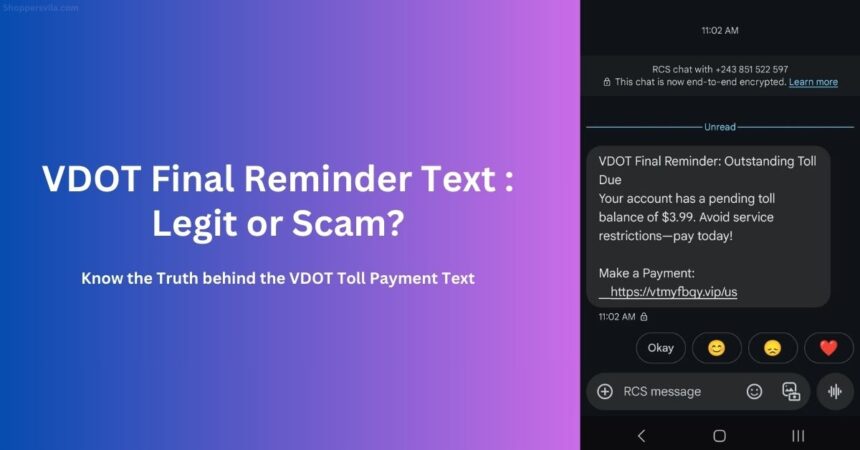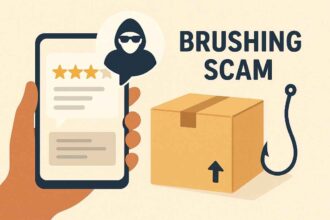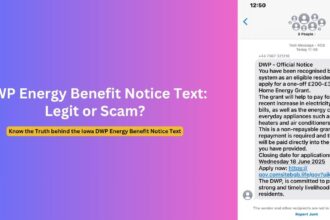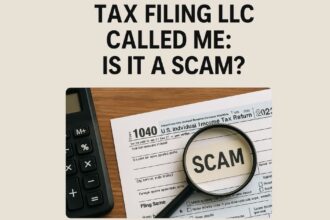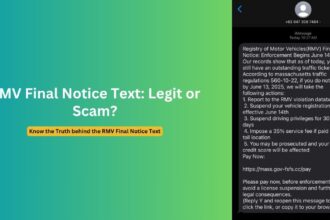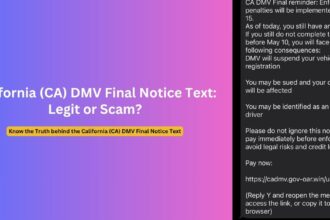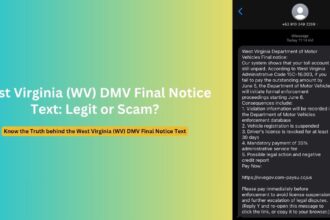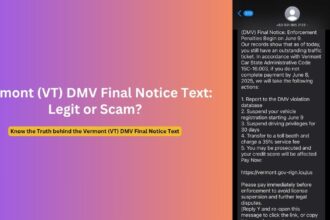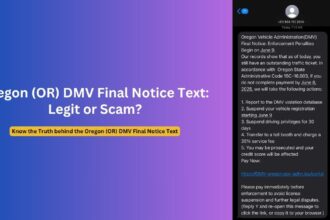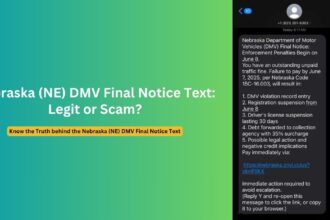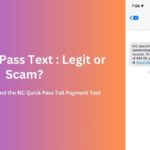A wave of fraudulent text messages claiming to be from Virginia transportation authorities has swept across the state, leaving many residents concerned about unpaid tolls they don’t actually owe. These sophisticated “smishing” attempts—SMS phishing scams—have prompted official warnings from the Virginia Department of Transportation (VDOT) and the Department of Motor Vehicles (DMV) as scammers exploit residents’ fear of penalties and service restrictions to steal personal and financial information.
Overview of the VDOT Toll Payment Final Reminder Scam Text
The scam begins with an urgent text message claiming to be from VDOT, E-ZPass, or another toll authority. These messages typically state that the recipient has an outstanding toll balance—often a small, believable amount like $3.99—and must pay immediately to avoid service restrictions, license suspension, or late fees.
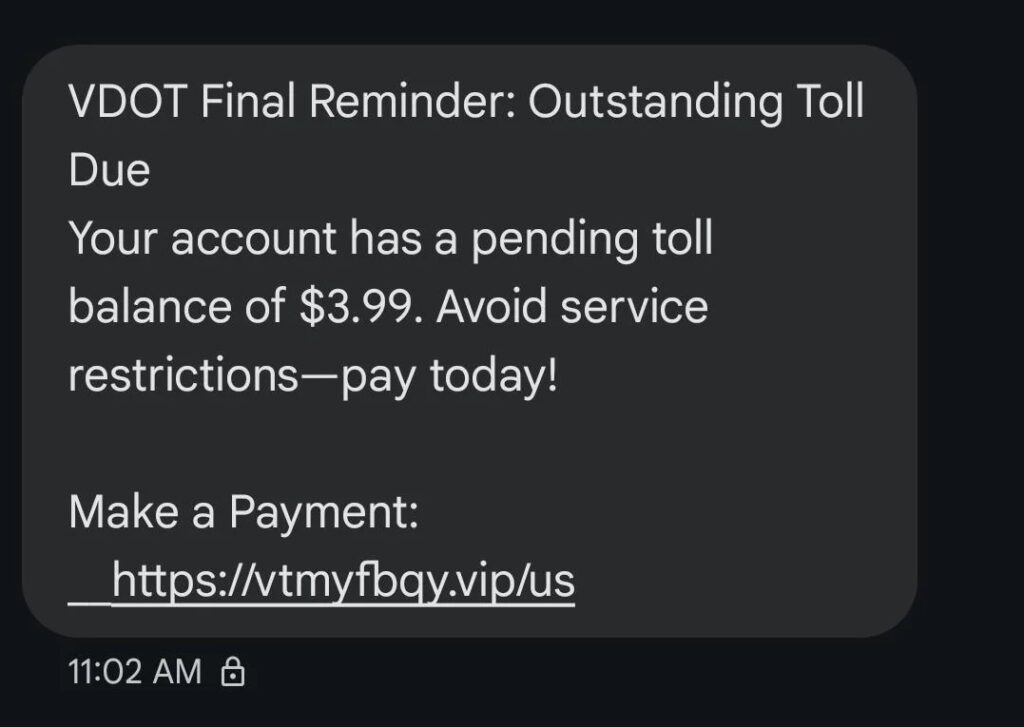
VDOT Final Reminder: Outstanding Toll Due. Your account has a pending toll balance of $3.99. Avoid service restrictions-pay today!
reads one common version of the message.
The text includes a suspicious link—often with domain names ending in .vip, .xyz, or other non-government extensions—that leads to a fake payment portal designed to harvest credit card information, account login credentials, and personal details.
What makes this scam particularly effective is its timing. Many recipients report receiving these messages shortly after traveling on highways with toll systems, creating just enough plausibility to make even cautious individuals second-guess themselves.
How Scammers Target Vulnerable Drivers
The scammers behind these fraudulent messages employ several psychological tactics to increase their success rate:
- Creating urgency: By framing the message as a “final reminder” and threatening consequences like service restrictions, scammers pressure recipients into acting quickly without proper verification.
- Using official-sounding language: Terms like “account,” “pending balance,” and “service restrictions” mimic the language of legitimate agencies.
- Setting reasonable amounts: By requesting small payments—typically under $5—scammers lower victims’ guard, as many people would rather pay a small fee than risk potential penalties.
- Wide-net approach: Fraudsters send these messages to thousands of phone numbers simultaneously, knowing that a significant percentage of recipients have used toll roads recently and might believe the message is legitimate.
- Exploiting unfamiliarity: Many drivers aren’t certain how toll violations are normally handled, creating an information gap that scammers exploit.
One victim, who wished to remain anonymous, shared their experience: “I had taken a toll road just 30 minutes before receiving the text, so I thought it was legitimate. After clicking the link and entering my information, my bank called about suspicious charges, including an $800 attempt at a Target in New York. I received scam calls every 10-15 minutes for days afterward.”
Red Flags: How to Identify a Toll Payment Scam
To protect yourself from these scams, learn to recognize these warning signs:
- Unexpected text communications: Virginia DMV Commissioner Gerald Lackey has explicitly stated, “The DMV will never send you text messages about toll bills.” Legitimate toll violations are communicated through official mail.
- Suspicious URLs: Official government communications will direct you to websites ending in .gov, not domains like .vip, .xyz, or other unusual extensions.
- Poorly written messages: While some scam texts are well-crafted, many contain spelling errors, unusual punctuation, or random emojis. Some victims have reported receiving toll scam texts containing coffee cup emojis or hand-shaking symbols.
- Missing account details: Legitimate toll authorities already have your vehicle and account information. If the message asks for information they should already know (like your zip code), it’s likely fraudulent.
- Urgency and threats: While legitimate toll notices may mention penalties for non-payment, they typically provide reasonable time frames for response and don’t threaten immediate consequences.
- Unusual payment methods: Be suspicious if the message directs you to pay using gift cards, cryptocurrency, or wire transfers.
What to Do If You Receive a Suspicious Toll Text
If you receive a text message claiming you owe toll payments:
- Don’t click any links in the message. These can lead to phishing websites or download malware to your device.
- Verify independently: If you’re concerned about possible unpaid tolls, contact Virginia’s toll authorities directly through official channels:
- Visit tollroadsinvirginia.com
- Call E-ZPass customer service at their official number (not one provided in the text)
- Check your E-ZPass account through the official website or app
- Report the message: Forward suspicious texts to 7726 (SPAM) to help mobile carriers identify and block scam numbers.
- Document the attempt: Take screenshots of the message before deleting it, especially if you think you might need to file a police report later.
- Delete the message after reporting it to prevent accidentally clicking the link later.
Protecting Yourself from VDOT Toll-Related Text Scams
Beyond responding appropriately to suspicious messages, you can take proactive steps to protect yourself from toll-related scams:
- Know how toll violations work: In Virginia and most states, legitimate toll violations are sent via postal mail to the registered owner of the vehicle. Many systems use “Pay by Plate” technology that photographs your license plate and mails a bill to the registered address.
- Keep toll receipts: If you pay tolls in cash, keep your receipts until you’re certain the transaction is complete.
- Monitor your E-ZPass account: Regularly check your legitimate E-ZPass account for any unusual activity or unexpected charges.
- Enable multi-factor authentication: If you manage your toll accounts online, enable additional security features like multi-factor authentication when available.
- Consider a credit card freeze: Some security experts recommend freezing your credit if you frequently travel through areas with toll systems, making it harder for scammers to open new accounts in your name if they obtain your personal information.
- Stay informed: Follow VDOT and Virginia DMV on social media for the latest updates on scams targeting Virginia drivers.
If You’ve Already Fallen Victim
If you’ve already clicked a link or provided information in response to a suspicious toll message, take these steps immediately:
- Contact your financial institutions: If you provided credit card information or bank details, contact your bank or credit card company immediately to freeze accounts and dispute fraudulent charges.
- Change passwords: If you used existing account credentials on the scam site, change those passwords immediately on legitimate sites, and any other accounts where you’ve used the same password.
- Place a fraud alert: Contact one of the three major credit bureaus (Equifax, Experian, or TransUnion) to place a fraud alert on your credit report.
- File an identity theft report: Visit IdentityTheft.gov to report the incident and get a personalized recovery plan.
- Monitor accounts closely: Check your credit card and bank statements frequently for unusual activity.
- Report to authorities: File a report with:
- Local police department
- Virginia Attorney General’s Office
- Federal Trade Commission at ReportFraud.ftc.gov
The Broader Threat of Smishing in Virginia
This toll scam is part of a growing trend of “smishing” attacks targeting Virginians. The FBI defines smishing as phishing scams delivered via text message, and they’re becoming increasingly sophisticated.
According to cybersecurity experts, text message scams have several advantages for fraudsters. They’re less filtered than email, have higher open rates, and create a greater sense of urgency. Many people are also more likely to trust and respond to text messages than emails.
The Virginia toll scam first appeared in significant numbers in August 2024, and after a brief lull, has returned with greater frequency in early 2025. Security analysts suggest this pattern indicates an organized criminal operation rather than isolated attempts.
“These aren’t random scammers—they’re targeting specific geographic areas where toll roads are common, and they’re timing their campaigns to coincide with heavy travel periods,” explains cybersecurity analyst Maria Hernandez. “The level of coordination suggests a sophisticated operation.”
As these scams evolve, authorities recommend maintaining a healthy skepticism toward unexpected communications about financial matters, particularly those creating urgency or fear. Remember the golden rule of digital security: when in doubt, verify through official channels you know and trust.
For more information about Virginia’s toll facilities or to access your legitimate E-ZPass account, visit tollroadsinvirginia.com.
